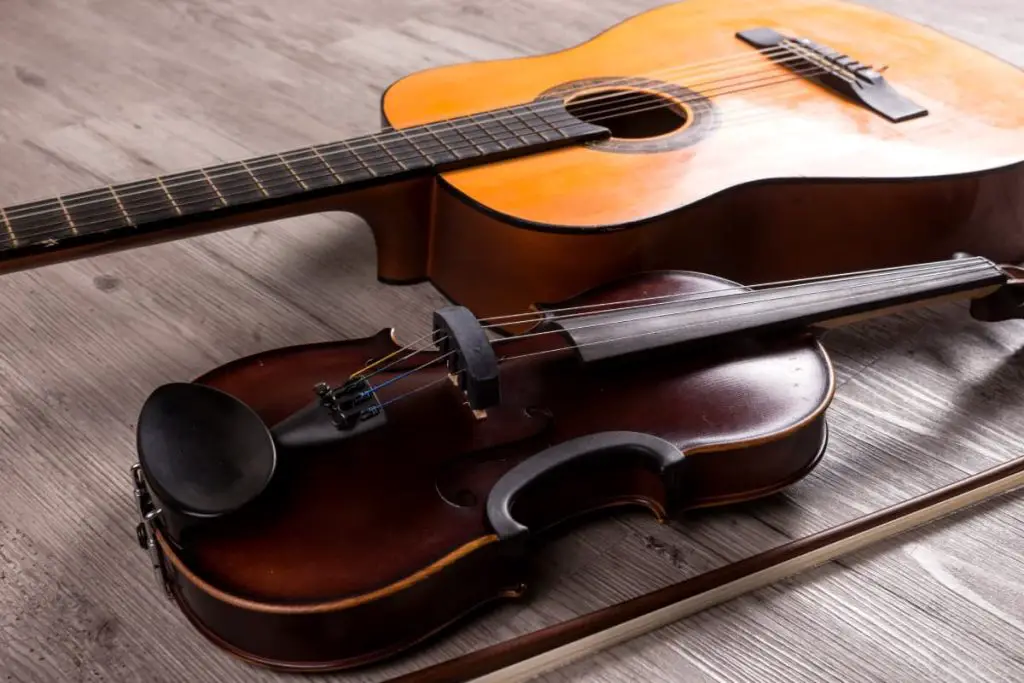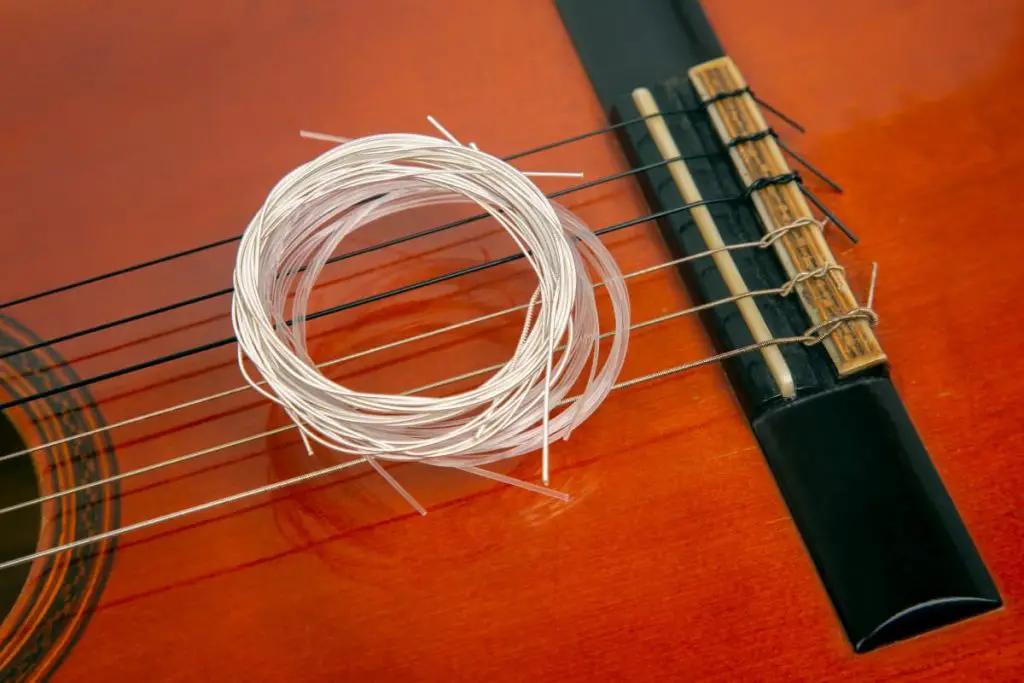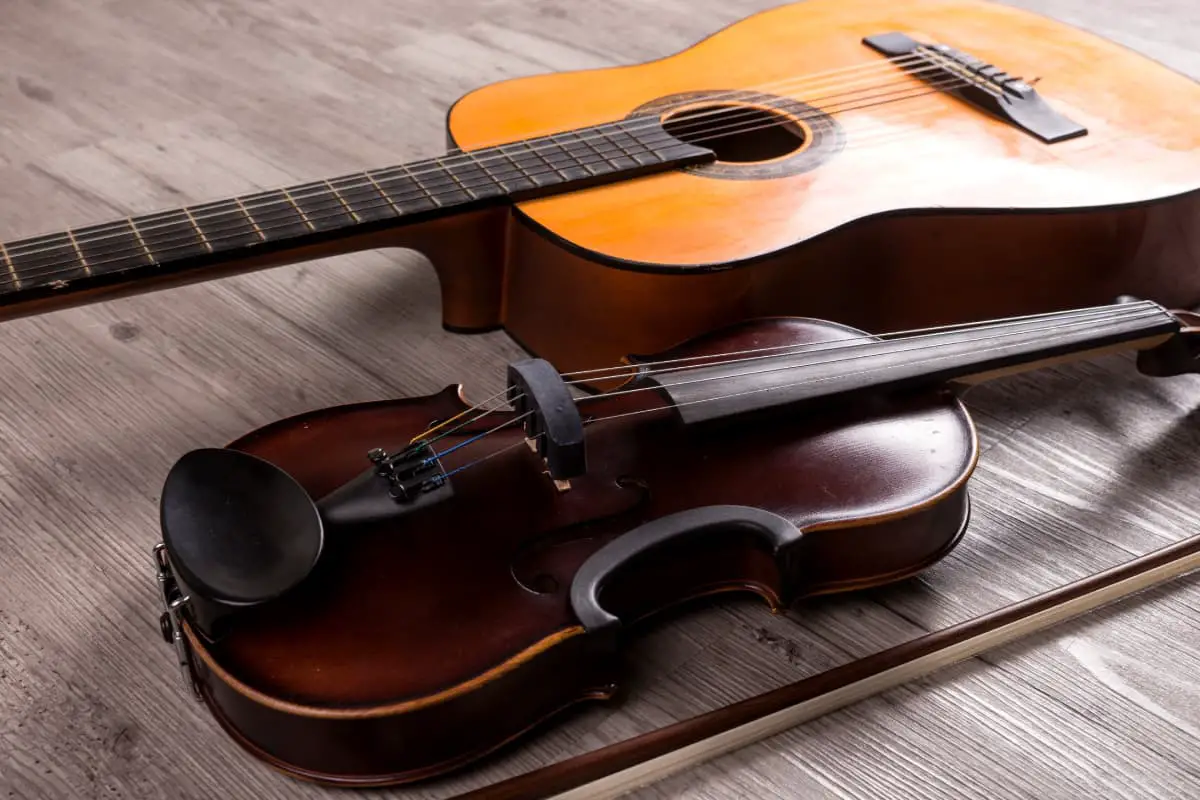Are you planning to take music lessons but find yourself deciding between learning the guitar or the violin? Both instruments require hard work and dedication to master. Although they are both string instruments, violins and guitars are very different from one another.
Here are the five major differences between a guitar and a violin:
- The number of strings used.
- How the instrument is played.
- The size of the instrument.
- Guitars have frets.
- There are more notes on the violin.
Below, I’ll tell you how the violin and guitar are different from one another. This article will also explain why these differences are significant for each instrument.
👇😀👇NOTE👇😀👇
If you want to find out what my recommended guitar gear is, then here is what I recommend on Amazon:
- Fender Cutaway Acoustic-Electric Guitar Bundle (MY FAVORITE GUITAR)
- Snark SN-8 Super Tight All Instrument Tuner (Easiest Tuner I’ve Used😏)
- 6 String Acoustic Guitar Capo (Best CAPO for quick changes)
- Dunlop Max Grip 1.0mm Nylon Picks (Thick Guitar Pick So You Don’t Lose Grip!)
- Universal Guitar Stand (Cheap & Minimalist Guitar Stand I Recommend)
- Levy’s 2″ Wide Quick Adjust Guitar Strap (Best Guitar Strap For Any Level)

1. The Number of Strings Used
You might first notice that the violin has fewer strings than the guitar. The standard guitar is strung up with six strings. Violins only have four strings, like other members of the string orchestral family.
Sometimes, you may find guitars with more than the standard number of six strings, but these guitars are usually custom-made. You can get seven-string, eight-string, and even twelve-string guitars.
Violins can also come with additional strings, but this is uncommon. Again, these instruments are custom-made and usually have a lower or higher string. Five-string violins have a lower string added to the standard setup and are used in contemporary music because of the added range and versatility.
The string order of a standard six-string guitar is E, A, D, G, B, and E. The first E is the lowest string, increasing in frequency until the top E, which is the sixth string and last string.
The standard tuning of a violin is G, D, A, and E. Each string has a five-note interval between them, meaning they are tuned a fifth apart.
Materials Used for Strings
A variety of materials are used to make both guitar and violin strings. Choosing string material depends on the musician and the type of music they will play. It also depends on the variant of the instrument that the player is using.
Some musicians have a personal preference for the type of string used since different materials hold different kinds of sound qualities.
Steel
Steel strings are a popular option for violinists and guitarists because they have a quick response and a bright sound. Typically, these strings will have an inner steel core plated with another type of metal on the outside.
For guitars, the various types of steel strings used are:
- Pure steel
- Nickel plated steel
- Brass plated steel
- Bronze plated steel
Electric guitars primarily use pure steel and nickel plated steel strings. On the other hand, acoustic guitars are strung up with brass or bronze plated strings. Bronze plated strings sound warmer than brass plated strings.
Violinists who play fiddle music use steel-core strings more often than classical players. Steel strings are the cheapest option on the market, making them economical for beginners.
Steel-core strings are also a top-choice for most violin players because of their longevity and stable pitch. You can often find steel E violin strings available with various platings, such as:
- Pure steel
- Tin
- Gold
- Platinum
- Silver
Nylon
Classical guitars use nylon strings exclusively. Nylon produces a distinct, mellow tone that is well-suited for lighter music.
Classical guitars use nylon strings because they are more lightly braced than acoustic guitars, so they cannot withstand high-tensile strings. Nylon has lower tension than steel strings, so using steel strings on a classical guitar may cause its head part to snap.
The lower three strings of the classical guitar (E, A, and D) are wound with materials such as bronze or silver, but they retain a multi-filament nylon core. Clear nylon is used for the higher strings (G, B, and E) and is much softer to play than other types of strings.

Gut
Gut or catgut strings were the norm for stringed instruments before the invention of synthetic materials. These strings are derived from natural, organic material but don’t come from a cat’s intestine. Instead, they are made from sheep intestines.
Gut strings are known for their warm and complex tone, which some violinists and guitarists prefer. Historical musicians often use these strings to achieve historically informed performances, a growing movement in the music world.
However, gut strings don’t last as long as synthetic or metal strings. Overall, they are expensive to make and purchase, so they are rarely seen in everyday settings.
Synthetic Core
Synthetic core strings were invented during the 20th century. The leading manufacturer of this type of string is the Austrian company Thomastik-Infeld, which developed the Dominant range of strings with cores made of nylon.
Dominant strings remain widely popular to this day. They are made to produce a “gut-like” sound but are more stable in pitch and have a longer life than gut strings.
Here’s a basic set of Thomastik-Infeld 135 Dominant Violin Strings (available on Amazon.com) that is suitable for full-size violins.
2. How the Instrument Is Played
The guitar is a plucked string instrument; the violin is a bowed string instrument. Guitar players pluck or strum notes and chords using their fingers or a pick. With violinists, a bow is used to play the notes by pulling it across the strings, though plucking is occasionally used.
However, violinists and guitarists don’t pluck notes the same way. You pluck guitar strings with a vertical motion perpendicular to the floor. For violins, you would pluck strings using a horizontal motion instead, which is parallel to the ground.
There’s also a technical name for when you pluck violin strings — this technique is known as pizzicato. It is typically written by composers as a performance direction, so players know when they need to do it.

Ways To Play the Guitar
Guitarists play using their fingers or a pick to sound the strings. There’s a specific playing style when guitarists use their fingers to play both the melody and accompaniment line, known as fingerstyle playing.
Check out this YouTube video by Paul Davids, where he explains what fingerstyle is and introduces some songs for those interested in fingerstyle playing:
You can also use your hands to mimic percussive sounds by slapping, hitting, or tapping the guitar strings. Since the instrument’s body is quite solid, hitting the side of the guitar can produce a drum-like sound too.
Another way to play the guitar is to use a small, triangular piece of plastic called a pick. Picks can play a single string at a time or strum chords. Some prefer using a pick over their fingers because it is less painful.
The Guitar Pick
Guitar picks, also called plectrums, come in various sizes and thicknesses. The table below shows the different pick sizes available to players:
| Thickness | Measurements |
| Thin | 0.4mm to 0.6mm (0.016 inches to 0.024 inches) |
| Medium | 0.6mm to 0.8mm (0.024 inches to 0.031 inches) |
| Heavy | 0.8mm to 1.2mm (0.031 inches to 0.047 inches) |
| Extra heavy | 1.2mm and above (0.047 inches and above) |
Choosing the right pick takes time. Thinner picks suit players aiming for a softer playing style or light strumming. The thin material gives less resistance against the strings, so the sound that comes out is much more mellow than when using a thicker pick.
Thick plectrums are useful when you have a solo guitar line that you want to stand out. A thicker pick will give you more picking control when playing faster solo riffs. If you swap out a thin pick with a thicker one for strumming an acoustic guitar, you’ll notice that it sounds much louder than before.
Using the Violin Bow
Instruments of the string family use bows. For violins, bow lengths are measured based on the size of the instrument body. Smaller violins have shorter bows, which grow in length up to a full-size violin.
The bow looks like a stick with bow hair attached from one end of the stick to the other end. Bow hair is typically made from animal hair, most notably horse hair.
You can find violin bows made from the following materials:
- Wood
- Fiberglass
- Carbon fiber
- Wood and carbon fiber hybrids
The player must apply rosin to the bow hair to play the violin. Rosin makes the bow hair sticky, which provides friction when the bow is pulled across the strings, causing them to vibrate.
It’s also important for players to get the correct bow angle to play the violin well. On the other hand, guitar players spend less time getting the strumming or picking angle right, making it a more straightforward instrument to play.

3. The Size of the Instrument
A guitar is much bigger than a violin. Even the smallest standard guitar, a 1/4 guitar, is bigger than a full-size violin.
A guitar must be large because of how it’s meant to be played and achieve the right sound quality. With six strings with high tensile strength and thickness, the guitar’s body has to be big enough to accommodate the stress that the strings exert when wound onto the instrument’s body.
The smaller size of the violin lets the musician easily carry it on their shoulders. Additionally, the smaller sound box of the violin helps the instrument sound the notes in the higher registers. So the smaller instrument body is functional to get the right sound of the violin.
The Small Violin Has the Bigger Sound
Even though the violin is the smaller instrument, the sound it produces is much louder than what you would get with an acoustic or classical guitar. Electric guitars have amplifiers and pickups to help with volume since their bodies are not hollow and are made with solid, composite materials.
How can the violin be so loud? It’s all because of a tiny piece of wood in the violin — the sound post.
The position of the sound post matters in adjusting the volume of the violin. Moving the sound post closer to the fingerboard will make the violin sound louder while moving it in the opposite direction will decrease the instrument’s loudness.
However, the sound post isn’t responsible for the sound of the violin per se; it just helps it get a fuller tone and projection. This little stick also helps the violin sustain a tone for longer.
In contrast, the inside of a guitar is entirely hollow. The large chamber of the guitar doesn’t sustain notes very well, so the sound dissipates a short while after you pluck or strum the strings.
4. Guitars Have Frets
Frets are the metal strips along the neck of the guitar that tell players where the notes are. The arrangement of frets, also known as the fretboard, can be found on all guitars. Violins do not have frets; the fingerboard of the violin is made of a smooth piece of wood.
Having frets makes the guitar an easier instrument to learn and play than the violin since players get to know where the notes are easily. Additionally, there are markers on the fretboard of the guitar that follows a standard pattern.
The following positions of the fretboard have markers or dots on them:
- Third
- Fifth
- Seventh
- Ninth
- 12th
- 15th
- 17th
- 19th
- 21st
- 24th
The distance between a guitar’s frets gets narrower as you go down the fretboard. Some guitars may also have dots along the side of the neck for convenience.
Each fret represents a semitone, also called a half-step. Interestingly, the twelfth marker on the fretboard divides the scale length of the guitar precisely in half. The scale length is important for guitar sizing as it measures the distance between the nut and bridge of the guitar.
Different guitars have different total numbers of frets:
- Classical guitar: up to 19 frets
- Acoustic guitar: between 18-20 frets
- Electric guitar: up to 24 frets
The Violin Fingerboard
Violins don’t come with frets at all. Finger placement is important on the violin because you need to practice and have good listening abilities to make a note sound in tune. This is one of the reasons why the violin is considered a difficult instrument to learn.
Exact finger placement is important because even a slight shift in position will result in a pitch that is out of tune. In contrast, you can put your finger on any part in the space between a guitar’s frets, and you’ll still get the note you want — this is because the note is sounded when the string makes contact with the fret and is not affected by your finger.
However, with enough practice, violinists can easily get accurate, in-tune notes every time. Instead of having frets as a guide, violinists can visualize each half-step as a one-finger distance for each note.
5. There Are More Notes on the Violin
Although the guitar is the bigger instrument, the violin has a wider note range. The guitar with standard tuning has a range of almost four octaves — “almost” because it is four steps away from the full four octaves. On the other hand, the violin can play up to four octaves plus two more notes.
An octave is the interval between two notes with the same pitch, but one has double the frequency of the other. Within this range, there are twelve note divisions. So basically, a guitar has around 44 notes, and the violin has around 50.

However, there are some ways to extend the range of both instruments:
- Using alternate tunings
- Harmonics
Alternate Tunings
You can change the standard tuning of a guitar or violin to an alternate one. Tuning a string half a step or a whole step higher or lower means that each pitch you play on that string is also affected.
Electric guitarists commonly tune their lower E string down a whole step to a D, called Drop D tuning. This effectively extends the guitar’s range on the lower end by two extra notes. Drop D helps electric guitarists play power chords easily, which is achieved by placing a finger across the lower three strings on the same fret.
Typically, a guitarist will adopt alternate tuning to make it easier to play specific chord patterns.
For violinists, playing with alternate tuning is very uncommon. Since learning basic finger positions on the violin requires a lot of muscle memory and good hearing, playing on a string that is not the standard tuning is very difficult and confusing. However, some classical pieces instruct the performer to play using a non-standard tuning.
Scordatura is the Italian term that tells players when to use alternate tuning. This YouTube video by professional violinist Ray Chen explains what scordatura is and why it’s difficult for violinists to play:
Harmonics
There are two types of harmonics that a guitar and violin can play: natural harmonics and artificial harmonics.
Harmonics are amplified overtones. Overtones exist above the fundamental pitch, the latter being the pitch you normally hear when you play the instrument. Essentially, harmonics occur when you make the overtones of a note sound louder than its fundamental pitch by dampening a note to produce a high-pitched chime.
Playing harmonics takes time and practice, but you’ll manage to produce notes that sound much higher than what you would get on the fretboard or fingerboard.
👇😀👇NOTE👇😀👇
If you want to find out what my recommended guitar gear is, then here is what I recommend on Amazon:
- Fender Cutaway Acoustic-Electric Guitar Bundle (MY FAVORITE GUITAR)
- Snark SN-8 Super Tight All Instrument Tuner (Easiest Tuner I’ve Used😏)
- 6 String Acoustic Guitar Capo (Best CAPO for quick changes)
- Dunlop Max Grip 1.0mm Nylon Picks (Thick Guitar Pick So You Don’t Lose Grip!)
- Universal Guitar Stand (Cheap & Minimalist Guitar Stand I Recommend)
- Levy’s 2″ Wide Quick Adjust Guitar Strap (Best Guitar Strap For Any Level)

